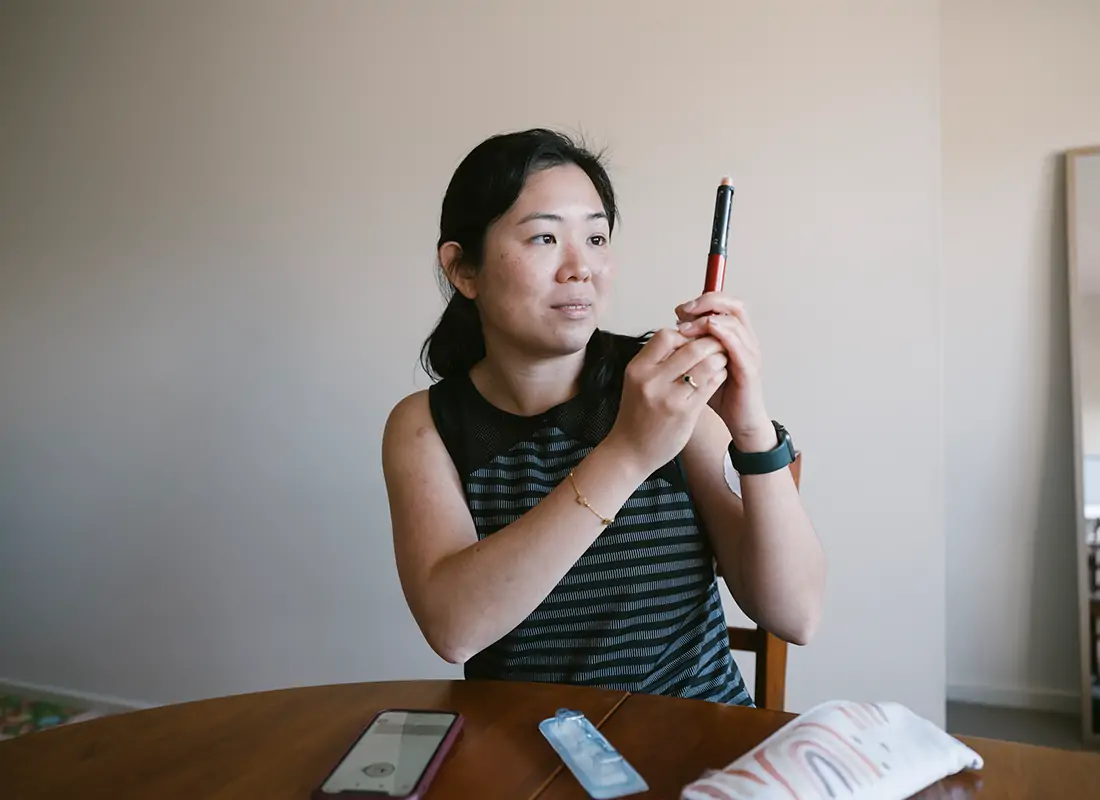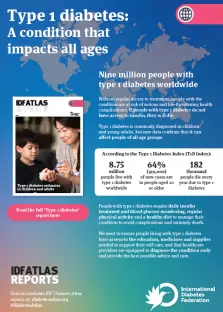If you have type 1 diabetes, your pancreas does not make insulin or makes very little insulin. Type 1 diabetes can affect people at any age but usually develops in children or young adults. People living with type 1 diabetes need daily insulin injections to control their blood glucose levels. If they do not have access to insulin, they will die.
In 2022, around 8.75 million people with diabetes were living with the condition, with 1.52 million under 20. We do not know what exactly causes type 1 diabetes. However, research shows that the possibility of developing the condition increases slightly if a family member has it. There are also environmental factors, such as exposure to a viral infection, which, in turn, triggers an autoimmune reaction.
Management of type 1 diabetes
People with type 1 diabetes require daily insulin treatment, regular blood glucose monitoring and a healthy lifestyle to manage their condition effectively.
Insulin
All people with type 1 diabetes need to take insulin to control their blood glucose levels. There are different types of insulin depending on how quickly they work, when they peak, and how long they last. The three most common ways to take insulin are with a syringe, an insulin pen or an insulin pump.
Types of insulin include:
Rapid-acting like Aspart, Glulisine and Lispro is taken with or before meals to limit blood sugar spikes quickly.
Short-acting , also known as regular or neutral insulin, is taken before meals. It is slower-acting than rapid-acting insulin but may be more suitable for some people. Actrapid, Humulin R, and Insuman Rapid are examples of short-acting insulin.
Intermediate-acting is usually taken with a short-acting one. It begins working within an hour of injection and reaches its peak activity within seven hours. Examples of intermediate-acting insulin are Humulin NPH, Protaphane, and Insulatard.
Long-acting can last up to 24 hours in the body and are usually taken in the morning or before bed. Some examples are Detemir and Glargine.
Two common insulin treatment plans include:
Twice-daily insulin: using both short-acting and intermediate-acting insulin.
Basal bolus regimen: short-acting insulin taken with main meals (usually three times a day) and intermediate-acting insulin given once or twice daily (evening or morning and evening).
Physical activity
Regular physical activity dramatically benefits people with type 1 diabetes. It improves cardiovascular health, builds strength, aids in weight management and helps manage blood glucose levels. Exercise also boosts mood, reduces stress, and increases mental well-being for a healthy lifestyle.
It is important to consider timing your physical activity to avoid low blood glucose (hypoglycaemia), which can occur during or after exercise, especially if insulin levels are too high or carbohydrate intake is too low. Recognising the signs of hypoglycaemia, such as dizziness, confusion, or shakiness, is essential for prompt treatment.
Before starting any exercise programme, consult your healthcare team to help you pick the best time for physical activity and choose an appropriate exercise plan based on your current fitness level, individual needs and insulin regimen.
Remember to:
- Adjust insulin dosage to prevent hypoglycaemia.
- For longer or intense workouts, consume additional carbohydrates.
- Monitor blood glucose levels during exercise and consume carbohydrates if needed.
Choosing a type of exercise
- Cardio exercises like walking, jogging, swimming or cycling can improve cardiovascular health, manage weight and increase insulin sensitivity.
- Strength training, using weights or resistance bands, can improve insulin sensitivity and blood sugar management and prevent muscle loss.
- Flexibility exercises like yoga and Pilates reduce the risk of injury and enhance physical performance.
Tips for safe and effective exercise with type 1 diabetes
- Aim for regular physical activity to maintain stable blood glucose levels and enhance the effectiveness of exercise.
- Listen to your body — if you experience unusual symptoms, check blood glucose levels and adjust intensity or activity as needed.
- Prevent dehydration and maintain normal blood glucose levels by drinking water before, during and after exercising.
- When exercising with others, educate them about your condition for a safe and supportive environment.
- Carry fast-acting carbs like glucose tablets or fruit juice in case of hypoglycaemia during exercise.
- Monitor and track the impact of your exercise routine on blood glucose levels, including insulin and carb adjustments, to make informed decisions.
Healthy eating for type 1 diabetes
People with type 1 diabetes can eat a variety of food without restrictions. The days of following strict guidelines are long gone, thanks to advancements in insulin regimens and delivery systems. However, to help keep blood glucose levels within the target range and delay or avoid diabetes-related complications, people with type 1 diabetes should follow a healthy and balanced diet that includes all major food groups.
The amount of carbohydrates you eat will affect your blood glucose level, so counting carbohydrate intake is essential to keep these levels stable. This means matching insulin to the amount of carbohydrates you eat and drink.
Choose healthier options such as:
- whole grains
- starchy foods
- fruits and vegetables
- pulses (legumes)
- unsweetened yoghurt and milk products
- nuts and seeds
Avoid sugary drinks and fruit juices for thirst because these can cause spikes in blood glucose levels. However, they can be helpful when treating episodes of low blood glucose — hypoglycaemia. Instead of sugary options, choose water or sugar-free drinks, tea and coffee.
Remember that moderation is key when consuming any food or beverage while managing type 1 diabetes.


Type 1 Diabetes Index
The Type 1 Diabetes (T1D) Index is a first of its kind data simulation tool that measures and maps the human and public health impact of type 1 diabetes. The Index uniquely illuminates the human impact of the condition by highlighting “missing people” and “healthy years lost” to type 1 diabetes.
The Index was developed collaboratively by JDRF, Life for a Child, International Society for Pediatric and Adolescent Diabetes (ISPAD), IDF and Beyond Type 1.
Go to the T1D IndexType 1 diabetes resources

Type 1 diabetes estimates in children and adults





